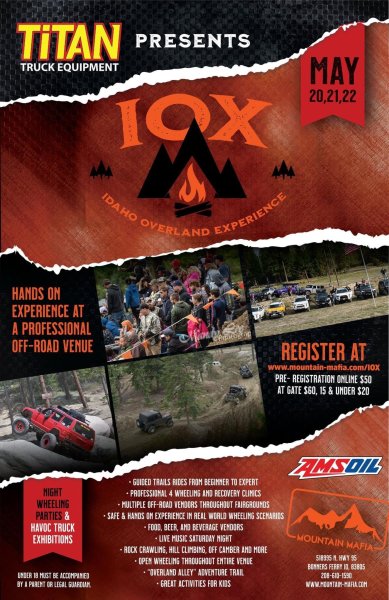Leaderboard
Popular Content
Showing content with the highest reputation on 05/16/2022 in all areas
-
A good friend of mine is a tribal member on the Colville Indian Reservation. I take him and a few other members excavators and dozers throughout the year. I am fairly well known there. I have guys stop to talk to me when they see me there, and I get a lot of waves (not all that uncommon in most rural areas of eastern Washington). I love going there actually. The Rez is a beautiful place. We will sit down and talk whenever we get the chance. When I told my friend that my uncle quit hunting due to the complications with the cancer he developed from handling Agent Orange in Vietnam, he and his family put together a big pack of game meat for him. I was astonished. (I still well up thinking about their generosity.) We talk about gold, logging, hunting, and the Stick Indian. My friend knows people on the Rez who have saw a lot of stuff. His neighbor has a video that I believe the neighbor and his brother took last year. It hasn’t gotten out yet. I saw a clip of it. My friend took a video of this gentleman’s video with his phone. The video is hard to see, but you can see a creature walking on two legs. Tribal tradition says that it’s bad luck to see a Bigfoot. These two brothers have not been back to the area since. They are very traditional, so I’m told. I have been waiting for the right time to ask about talking to witnesses there. That time was today. My friend is asking his neighbor if they will talk to me about what they saw. I’m hoping the door will now open for me. I also met a lady on the Rez who drives pilot car for the oversize loads there. I only talked to her on the cb when she took me in and helped me find an excavator I was looking for. My friend told me later to ask her about Bigfoot, she knows a lot. I am also working on getting her number. I have never interviewed someone before. What questions do you think I should ask? Is there a thread here that I am missing? Any advice is greatly appreciated. I will only post videos with permission out of respect for the individuals who took them.2 points
-
You can do it, it's not that hard. Good success to you, whatever you decide.1 point
-
Don't kick too hard! In my book, just going through the hoops is worth a trophy, I've a severe allergy to red tape! You'll get it next time! Thank you for the info. I've heard here and there that FRS/GMRS radios are not policed much, not that I'm insinuating one should use them without license. Ham is a different story though, I understand the users hunting down those skirting the regulations, a bit of a brotherhood there it seems. I have one of the cheap Boafangs for emergency use, which has never been transmitted from. I'll remedy the license issue at some point soon.1 point
-
1 point
-
1 point
-
Hey WL......appreciate the post and thanks for reading! Since Lulu's passing, it has been different hiking alone....it was not only Lulu but my male Rhodesian Ridgeback Duncan that went with me......he's still alive but 17 now and can't hike anymore. As stated before, I truly believe Lulu was interacting with the hairyman, and in particular 'the kid', as I think he was in charge of keeping an eye on me. She knew what I was looking for, and found a lot of the tracks and other interesting things just by following her. Yep, I need another Lulu!1 point
-
Hello folks, I started really following the subject after my own encounter in 2002, or at least what I believe was a encounter. It’s definitely left me with more questions then answers, but I’m sure that’s with all of us. I spend lots of time in the outdoors, backpacking and hiking are what keeps me out there, and as of 2002 , this giant has grabbed my attention for now 20 years…I hope to gain more knowledge by being here and look forward to participating.1 point
-
Some scary stuff there, norseman. I've been up close to a couple of hyenas at a local private game preserve where a family friend worked. There was a very heavy chain link fence between myself and them, and they were snarling viciously at me through it, giving me genuine shivers. I can imagine the terror of any hominid facing a pack of them with only a spear or club! Their chances would be very poor indeed.1 point
-
1 point
-
http://patagoniamonsters.blogspot.com/2019/12/chapala-homo-erectus-brow-ridge.html?m=11 point
-
Hi Tony, hope all is well ? I've answered above within your post, in bold . BobbyO, Thanks much for your reply and all your comments to my questions. On the coyote sounds, I am very interested in what these warning/locator calls sound like, so that when I go to the field I can identify them. In researching the internet for coyote sounds, I found the followings 3 sites (shared below for whoever is interested). https://pickhunting.com/what-does-a-coyote-sound-like/ This website lists 11 types of coyote sounds and has sound clips of many of them (but not all). Quoting from this site: "According to studies, a coyote can make eleven different types of sounds. All these sound patterns have different intensity, loudness, and frequencies." Woof: Woof calls are made by parent animals especially when they want to push their cubs in a hidden place or den. These sounds are usually low-pitch alarms in case of impending dangers or predators. Adult dogs often utter woof like vocals close to the den or bedding areas of pups. It sounds like. Wooo….ooo. Growl: Growls are low warning sounds but with high pitch which means don’t come closer. Such sounds can be heard when puppies fight each other during mating. These are in fact warning signals from coyotes to another coyote. Sometimes growling accompanies barking if danger is not so far. It seems as these vocals are uttered from the deep throat as Oo…OO..oooooo Huff: Huff calls are also high pitch warning vocals. These sounds are produced both from nostrils and mouth. Animals push air forcefully out through the nose to produce such sounds. So, these are less like sound and more pressure of air from noise. These calls mean to stop unwanted advances of a fellow coyote or even other animals. Bark: Barking sounds of a coyote resemble a dog. Such sounds are most common and it is difficult to identify between dog bark and coyote bark. They bark for several reasons. Mostly they do so while talking to other fellows. In case of danger and unwanted advance, they also bark in a loud pitch long-note voice. This barking sounds like.OO…Hoo.HooooooooooOo Yelp: Yelp sounds are expressive and made in excitement. Young ones make yelp noises while playing with others. These vocals are high intensity but short note sounds. Such sounds mean we are happy. Whine: Whines are expressive notes in case of distress, pain or hunger. During delivery, female coyotes whine with pain. Young ones whine in low pitch during hunger. High Pitch Whines: High pitch whines are agonistic sounds produced by leading animals. They show submission to subordinates. Bark howls: Bark howls are sounds in which coyotes bark and howl simultaneously. These sounds are meant for alarming signals and showing dominance over territory. Low pitch whines: Low-frequency whines include physical gestures also like tail wagging and muzzle nibling. These sounds are heard to attract the opposite sex in the mating season. Group collective howl: Group collective howls are multiple sounds at the same time. These are like greeting dog songs like Wooo….wo..ooo…wo.It seems as if a coyote pack is planning a party. Lost lone call: This call is extremely disturbing produced by infants when they lose parents. Pups make lost lonely call noise to call mothers or to tell them they are hungry. However, the author of that website did not identify the type of sounds corresponding to warning/locator call. Maybe the bark howls listed above is the alarm signal corresponding to warning/locator call? https://www.farmanddairy.com/columns/how-to-understand-coyote-vocalizations/375232.html This other website list 10 types of coyote sounds. The list is similar but not identical to the one above but does not have sample sound clips. However, after going thru the descriptions below, it is not clear where a warning/locator call will fall. Maybe a bark-howl per description below on threats? Types of Coyote Vocalizations: 1. Growl. This vocalization holds no mystery. A growl is used as a threat, specifically for something within close range. 2. Huff. This is the expulsion of air through the nose and mouth, and is also used as a high-intensity threat in close proximity. Huffs are used when there’s bickering over carrion. 3. Woof. This vocalization is made as both a low-intensity threat and as an alarm. It’s a sound made when a coyote is startled and unsure of exactly what is happening. 4. Bark. The bark is a long-distance threat or alert of low to medium intensity. 5. Bark-howl. This is when the coyote gets serious about a threat. The bark-howl is used as a long-distance high-intensity threat or alarm. It starts with a bark and blends into a howl. What is interesting about the bark and the bark-howl is that research suggests that the varying intensity and frequency of barks could contain different information. Howls stably convey information for distances of at least one kilometer. Barks, on the other hand, rapidly attenuated and did not appear suitable for transmitting information. 6. Whine. This sound is used to express submission and is usually given by a subordinate coyote to a more dominant coyote. 7. Yelp. The yelp takes the whine up a notch and represents high-intensity submission. However, it can also be a response to being startled. As is the case with several other of these vocalizations, this categorization shows that coyote communication is more of a gradient. 8. Woo-oo-wow. This is the greeting song of coyotes, and is used during high-intensity greeting displays. The vocalization modulates in frequency and amplitude as a coyote’s motivation shifts. 9. Lone Howl. The lone howl is just what you probably already know it to be: a howl by a single coyote, which is often started with a series of barks and can distinguish individuals. 10. Group Howl. A group howl is sent up when two or more coyotes come together after being apart, or it could be given as a response to the howls of distant coyotes as a way of giving out location information to any listeners. This 3rd link is a library of coyote sounds with 31 samples but unfortunately, the author does not divide them into the 10 or 11 types listed above. These sound clips include several coyote locator calls but they sound like a group collective howls. Not sure if the definition used in the Olympic nest study is the same as this library. https://www.101soundboards.com/boards/28565-coyote-calls I will pay more attention to coyote sounds and vocalizations next time I am out in the field to see if I can identify these different types of sounds.1 point
-
Here it is.. https://www.youtube.com/watch?v=6DSKrJaARs0&t=37s1 point
-
Hello, my name is Doug and I am from North-West Ohio. I've been interested in bigfoot since I was a kid and watch 'In Search Of...' with Leonard Nemoy back in the 70's. But my interest in the subject really peaked when in 2017 I happen to come across a facebook post about a bigfoot talk being held at a local library. That's where I met Marc DeWerth, the coordinator of the Ohio Bigfoot Conferences. Since then I've been to 3 Conferences and read several books on the subject. My favorite so far is Dr. Jeff Meldrum's Sasquatch: Legend meets Science. Looking forward to learning more here and hearing all of your experiences.1 point
This leaderboard is set to New York/GMT-05:00










